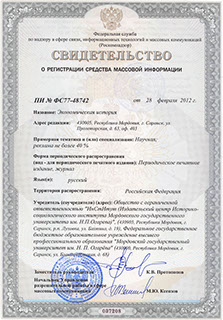Экономическая историЯ
Russian Journal of Economic History
ISSN 2409-630X (Print)
ISSN 2618-916X (Online)
Expert board:
- Scientific Council of RAS on economic history;
- Research and Educational Center «The economic history of Central Russia and the Middle Volga region» of Ogarev Mordovia State University;
- Center of Economic History of Lomonosov Moscow State University
Navigation
Certificate of registration

ISSN 2409-630X (Print), ISSN 2618-916X (Online)
DOI: 10.15507/2409-630X.063.019.202304.318-327
УДК 94(470.53)
Vladimir A. Arestov
Perm State National Research University (Perm, Russia),
e-mail: arestovvolodya@yandex.ru
Petrovsky Agricultural Fair in the Years of the New Economic Policy (Based on the Materials of the State Archive of the Perm Region)
Abstract
Introduction. Since 1921, the country has been going through a period of economic experiments, a period of aggravation of the political struggle over the further development of Russia. This stage has gone down in history under the abbreviation NEP – New Economic Policy. The new economic policy has had a great impact on the daily, private lives of people, until recently insufficiently studied. The NEP period causes controversy among modern researchers of the Soviet Union, as well as disagreements in their assessment. The relevance of the topic of NEP is explained by the socio-economic and political changes that have occurred in Russian society in recent years, the transition to market relations. The experience of the “mixed economy” of the 1920s seems to have great practical significance for modern economic and political development.
As such, this period was not marked by a holistic policy. There have been certain steps towards the recognition of various forms of ownership, the legalization of private entrepreneurship, and at the same time, a retreat to the position of strict state regulation, an economic dictate bordering on extortion. The purpose of the article is to consider the process of creation and functioning of fair trade in Perm during the NEP years, to analyze the impact of this practice on the daily life of citizens.
Materials and Methods. The study is based on a structured approach that considers the Soviet economy as a set of complexly organized enclaves. The modular approach can be described as a transition from a general analytical scheme to a set of derived analytical schemes or blocks of a lower degree of generality. A characteristic feature of the NEP – diversity – is an attribute property of the Russian economy, as a result, its study is an urgent task today. The term “way of life” is considered as a scientific category and its potential in the study of the economy of the transition period, including the NEP period. The “scale of patterns” formed by modern economists allows us to study in more detail the problems of the NEP, including the mechanism of functioning of the patterns that unite the most economically active segments of the population.
Results. The first, most significant feature of the Petrovsky Fair, as well as all fairs of the present moment, is the composition of firms and organizations that traded at the fair, which immediately changed in comparison with the pre-war time. The main figures and participants of both fairs in Perm turned out to be, due to the current economic situation, state trade enterprises. In second place in terms of turnover is cooperative trade. The size of private capital at the Petrovsky Fair was insignificant. Nevertheless, the unfolding fair trade of both fairs showed the economic power of state and cooperative trade and had a very significant impact on wholesale fair transactions during the Petrovsky Fair. Concluding the review of the results of the Petrovsky Fair, based on the available digital information and conclusions from them, it can be noted with confidence and satisfaction that the experience of the Petrovsky Fair, as the most important factor in the rapprochement of the city with the countryside and the restoration of the national economy, was successful, brought a significant revival of trade turnover and especially the resumption of lost ties and strengthening them.
Discussion and Conclusion. The proposed provisions and conclusions create prerequisites for further study of trade as a factor in stabilizing the social and political situation in the country.
Keywords: New Economic Policy, way of life, trade, Perm, fair, cooperative, competition.
For citation: Arestov V. A. Petrovsky Agricultural Fair in the Years of the New Economic Policy (Based on the Materials of the State Archive of the Perm Region). Ekonomicheskaya istoriya = Russian Journal of Economic History. 2023; 19(4): 318–327. (In Russ.). DOI: 10.15507/2409-630X.063.019.202304.318-327.
© Ogarev Mordovia State University. History and Sociology Institute, 2017
68, Of. 411, Bolshevistskaya St., 430005, The editorial office of the scholarly journal «Russian Journal of Economic History»
Tel.: (8342) 24-25-90; 27-07-11, Fax: (8342) 24-25-90, E-mail: jurnal-econom-hist@isi.mrsu.ru
Designed by A. Napalkov, Email: napalkov@isi.mrsu.ru

